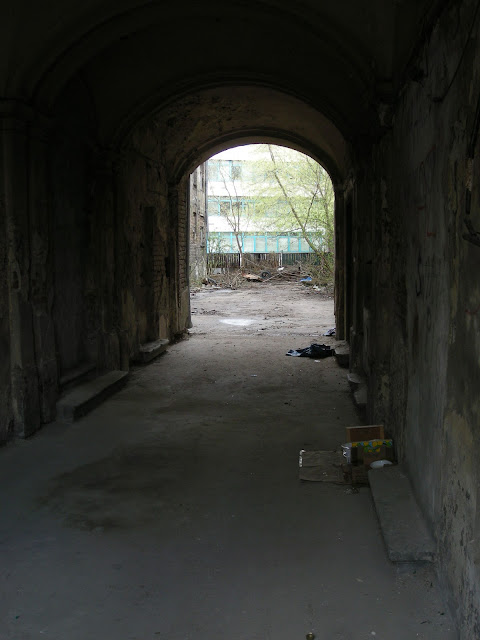A walk around Warsaw showing the crumbling evidence of finery long gone
 |
| ul Zlota 83 |
Working in Warsaw, running around town from meeting to meeting, means probably most of us don't see whats above us or around us.
As Warsaw develops, its history and past is infringed on, buildings crumbling due to lack of funds or ownership disputes. New development changing the landscape as well.
Warsaw however has quite a few buildings in the centre, listed as monuments, pre war buildings mainly which sit miserably awaiting their fate.
Whether that fate is to receive the ball of the demolition expert or to be restored to their former finery, is in the hands of the City of Warsaw who own nearly all of them.
The City says it has no funds to renovate them, but demands huge sums from prospective purchasers, who face a hefty bill to restore the buildings, given the monument status, and the over zealous attentions of the Conservator appointed by city hall.
Even though a few are lived in, most lie empty, barred and closed a former shadow of themselves, city assets, crumbling away until deemed unsafe, and then of course need to be demolished.
On a walk around Srodmiescie, Mirow and Wola its possible to see many of these buildings, some we know who owned them, most we don't. However their design and finery is still visible even though time and the war have taken their toll.
Rather that write more, lets just see these buildings street by street, where there is infomation about builders, architects and designers , even residents it is mentioned underneath the photos.
ul Zlota 83"Kamienica Wolf Krongold
 |
| Today |
Built in an eclectic style with a richly decorated facade crowned by a wide frieze and cornice. The Attic butress on the corner adorned with statues of two reclining figures. One of them was an old man who symbolised the 19th century, the other was a young man symbolising the 20th century. Between the statues the date of construction, 1899 is enscribed.
The front staircase was decorated with white marble. The hand-made iron railings adorned with rosettes. Appartments were equipped with beautiful woodwork, floors and stoves.
Zlota 83 became known locally in Warsaw as
 |
| Pre War |
appartment. Occupants were mainly the families of craftsmen who worked in local factories such as Norblin. After the war the appartments were divided in to smaller ones, and the kamienica sufferred the same fate as other at the hands of the communist government. Its facades were stripped and destroyed, stone balconies, and metal railing removed, as were the hand forged and highly decorated main gates.
Now occupants were those on the margin of society, an underclass to quote Jerzy Majewski of Gazeta Wyborcza.
The residents of Pekin, were immortalised in a documentary film made by Eva Borzecka shortly before their eviction in 2003, it was shown on TVP, and showed despite the degradation of the building the extent of the finery of its interior. The documentary whilst fascinating, is also sad. Seeing a close community with severe problems of alcohol and drug abuse, poverty and bad living conditions disintergrate despite being closely tied together by friendship is tragic. Morevoer the thing which bound them all together, people fallen from grace from all classes, and habits, is the thing which ended their community- the building. As it became dangerous, tenants were evicted, many to an uncertain future with no home. The documentary shows the harsh hand of cards that life can be repeatedly dealt to those least able to cope.
Ul Chmielna 128 and 130
Two Kamienicas, standing side by side, one inhabited, and lovingly kept tidy by its residents, the other in ruins, deserted and locked. The contrast between the two in quite stunning.
 |
| Ul Chmielna 130 Kamienica Nisenszlow |
 |
| Ul Chmielna 128 Kamienica Garsztajnow |
ul Chmielna 130 is still inhabited, and has a lovely entrance in excellent condition, where you walk through, in to the open courtyard garden, which is kept tidy and has a Christian shrine, the detail on fittings in the entrance hallway has lasted since it was built, and shows that pre war occupants must have been well off indeed.
 | ||
| ul Chmielna 130 entrance |
 | ||
| ul Chmielna 130 |
 | ||
| ul Chmielna 128 |
 | |||||
| ul Chmielna 128 |
One kamienica alive, surviving and inhabited, the other crumbling and looking like a set for a computer battle game. I can't really say more about these two buildings because no one knows anything of the history of the builders, owners or former occupants, except that they were lost in the war.
Now lets pop around to ul Zelazna to number 43a, a parade of shops with flats above and behind through the archway a double kamienica. In other words a courtyard leading to another enclose courtyard.
Here more evidence of wealth, finery and style. Beautiful facade decorations in hallways, iron work and ceramics clearly showing rich people lived here.
A former tailors or fabric shop with red and black marble on the outside of the shop and lapis lazuli tiles underneath. Peering through the window you can see dark hardwood counters, and garment hanging and movement systems. Nearly every shop, locked, shut, the kamienica locked too. The building sat waiting for its fate.
 |
| ul Zelazna 43a |
 | ||
| The window says it all |
 | |
| Entrance and view to 1st and 2nd courtyards |
 |
| Facade and tile work in the entrance ul Zelazna 43a |
 | |
| Tiling and door facade work |
 | |
| Close up on facdade |
 | |
| Door post |
 | |
| Fabric shop |
 |
| Red marble on the shop front with Lapis Lazuli tiles underneath |

